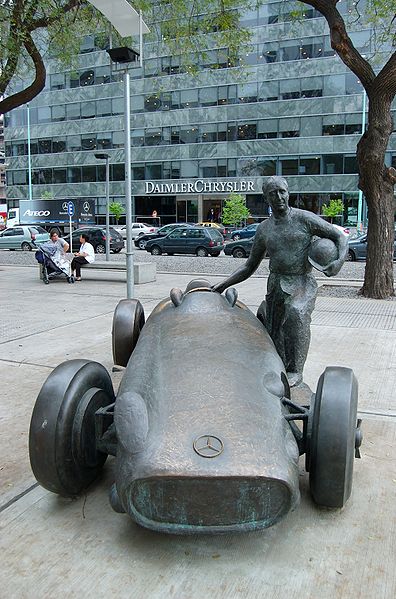<Back to Index>
- Race Car Driver Alberto Ascari, 1918
- Race Car Driver Juan Manuel Fangio, 1911
PAGE SPONSOR
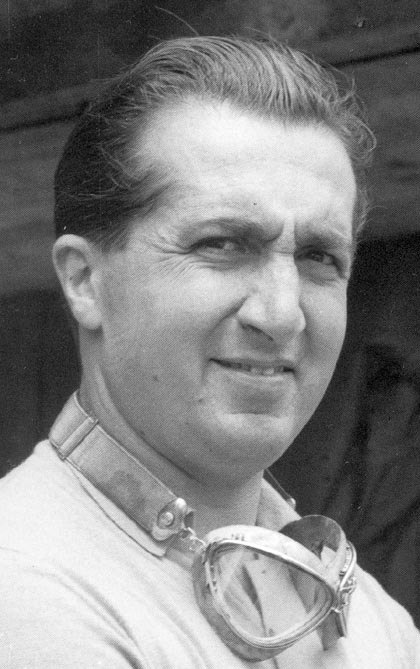
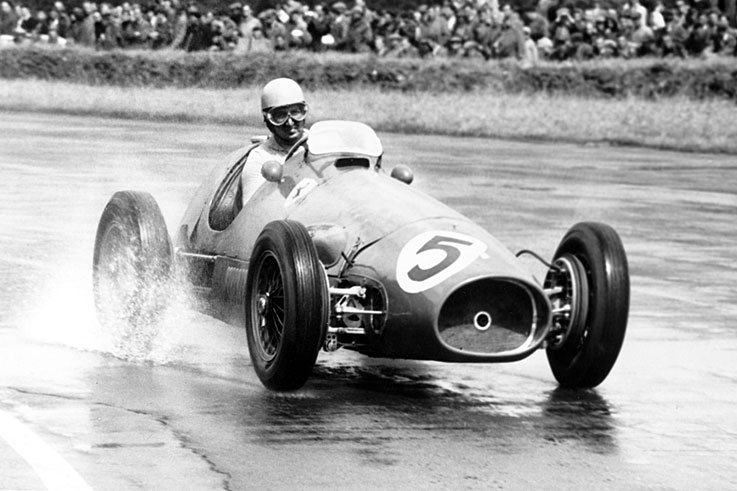
Alberto Ascari (13 July 1918 – 26 May 1955) was an Italian racing driver and twice Formula One World Champion. He is one of only two Italian Formula One World Champions in the history of the sport, and the only one to win his two championships in a Ferrari.
Born in Milan, Ascari was the son of Antonio Ascari, a talented Grand Prix motor racing star in the 1920s, racing Alfa Romeos. Antonio was killed while leading the French Grand Prix in 1925 but the younger Ascari had an interest in racing in spite of it. He raced motorcycles in his earlier years; it was after he entered the prestigious Mille Miglia in a Ferrari sports car that he eventually started racing on four wheels regularly.
Following the end of World War II Alberto Ascari began racing in Grands Prix with Maserati. His team mate was Luigi Villoresi, who would become a mentor and friend to Ascari. Formula One regulations were introduced by the FIA in 1946, with the aim of eventually replacing the pre-war Grand Prix structure. During the next four transitional years, Ascari was at the top of his game, winning numerous events around Europe. He won his first Grand Prix race in Sanremo, Italy, in 1948 and took second place in the British Grand Prix the same year. Ascari won another race with the team the following year. His biggest success came after he joined Villoresi on the Ferrari team; he won three more races that year with them. The first Formula One World Championship season took place in 1950, and the Ferrari team made its World Championship debut at Monte Carlo with Ascari, Villoresi, and the popular French driver Raymond Sommer on the team. Ascari finished 2nd in the race and later in the year shared a 2nd place at the first World Championship race at Monza. He was only 5th in the championship standings however. He won his first World Championship F1 race the following season on the Nürburgring circuit and added a win at Monza, finishing runner up in the championship to Juan Manuel Fangio.
With success in Europe, Enzo Ferrari supplied a car for Ascari in the Indianapolis 500, at the time a World Championship event, in 1952. He was the only European driver to race at Indy in its 11 years on the World Championship schedule, but his day ended after 40 laps. That was the only World Championship event in which he competed that season that he did not win. Ascari's Ferrari Tipo 500 dominated 1952, winning all six races in Europe that season and recording the fastest lap in each race. He scored the maximum amount of points a driver could earn, since only the best four of eight scores counted towards the world championship.
He won three more consecutive races to start the 1953 season, giving him nine straight wins (not counting Indy) before his streak ended when he finished 4th in France, although it was a close 4th as the race was highly competitive. He earned two more wins later in the year to give himself a second consecutive World Championship. Ascari switched to Maserati and Lancia in 1954 but did not continue his dominance as he failed to finish a race in his four attempts at F1, although he made up for it by winning the Mille Miglia.
His 1955 season started similarly, retiring twice more, the latter of which was an incident in Monaco where he crashed into the harbor after missing a chicane. Four days later, on 26 May, he went to Monza to watch his friend Eugenio Castellotti test a Ferrari 750 Monza sports car, which they were to co-race in the Supercortemaggiore 1000 km race (having been given special dispensation by Lancia). Just before going home to have lunch with his wife Mietta, he decided to try a few laps with the Ferrari. In shirt sleeves, ordinary trousers and Castellotti’s helmet he set off. As he emerged from a fast curve on the third lap the car unaccountably skidded, turned on its nose and somersaulted twice. Thrown out on the track, Ascari suffered multiple injuries and died a few minutes later.
The crash occurred on the Curva di Vialone, one of the track's challenging high speed corners. The corner where the accident happened, renamed in his honor, no longer exists, having been replaced with a chicane, the Variante Ascari.
Legend has it that Ascari was a very superstitious man and would always insist on using his distinct pale blue crash helmet. On the day he died, his helmet was not available, so he borrowed Castellotti's white one. The helmet was at the repair shop, having a new chin strap fitted after the incident in Monte Carlo which saw Ascari's Lancia take a dip in the Monaco harbor.
The eerie similarities between the deaths of Alberto and his father still haunt his fans to this day. Alberto Ascari died on 26 May 1955, at the age of 36. Antonio Ascari was also 36 when he died, on 26 July 1925 (Alberto was only 4 days older). Both father and son had won 13 championship Grand Prix and drove car number 26. Both were killed four days after surviving serious accidents and on the 26th day of the month. Both had crashed fatally at the exit of fast left hand corners and both left behind a wife and two children. Fans from all across the globe mourned as Alberto Ascari was laid to rest next to the grave of his father in the Cimitero Monumentale cemetery in Milan, to be forever remembered as one of the greatest racers of all time.
A distraught Mietta Ascari told Enzo Ferrari that "were it not for their children she would gladly have joined her beloved Alberto in heaven".
Another curiosity is that the only other driver to crash into the harbor at Monaco in the circuit's history, Paul Hawkins, also died on 26 May. Hawkins crashed into the harbor 10 years after Ascari, before dying when his Lola crashed into a tree at a Tourist Trophy race at Oulton Park in 1969.
The British manufacturer, Ascari Cars of the Ascari KZ1 supercar is named in his honor.
In 1992, he was inducted into the International Motorsports Hall of Fame.
There is a street in Rome (in the EUR region) named in his honor.
The Ascari Chicane at Autodromo Nazionale Monza is named after him.
Italian born American racing legend Mario Andretti counts Ascari as one of his racing heroes, having watched him at the Monza circuit in his youth.
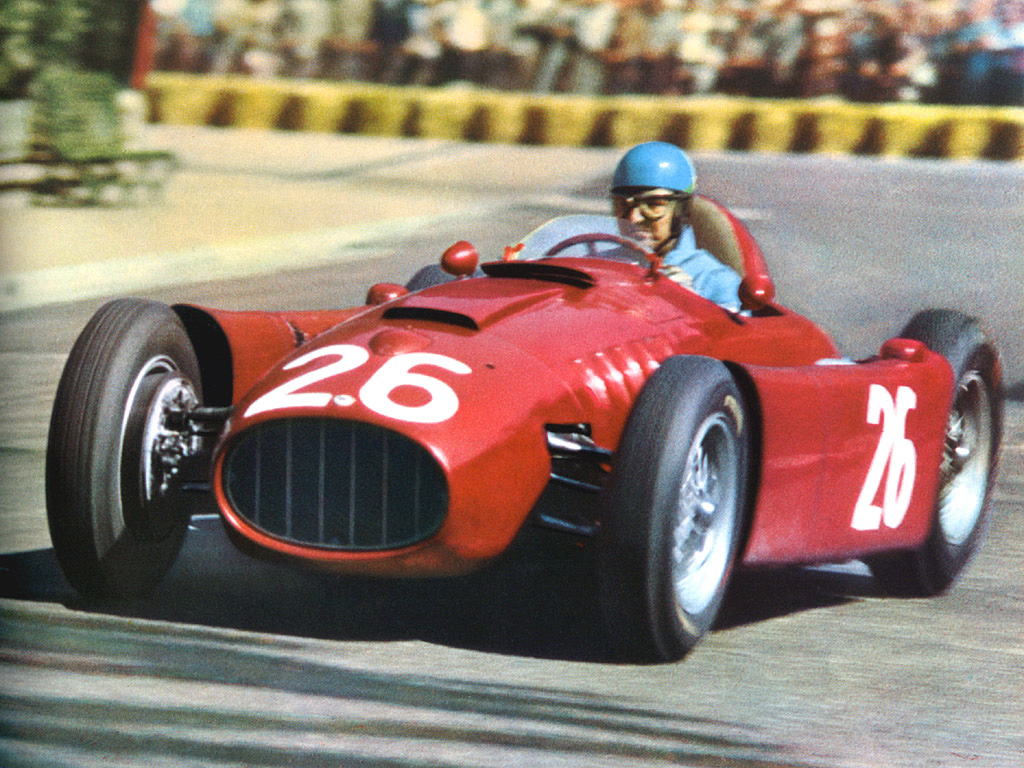
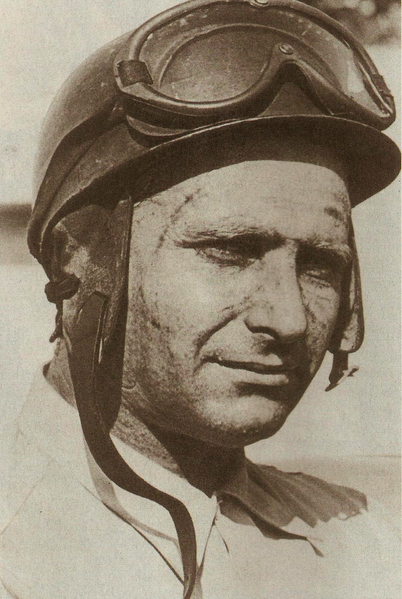
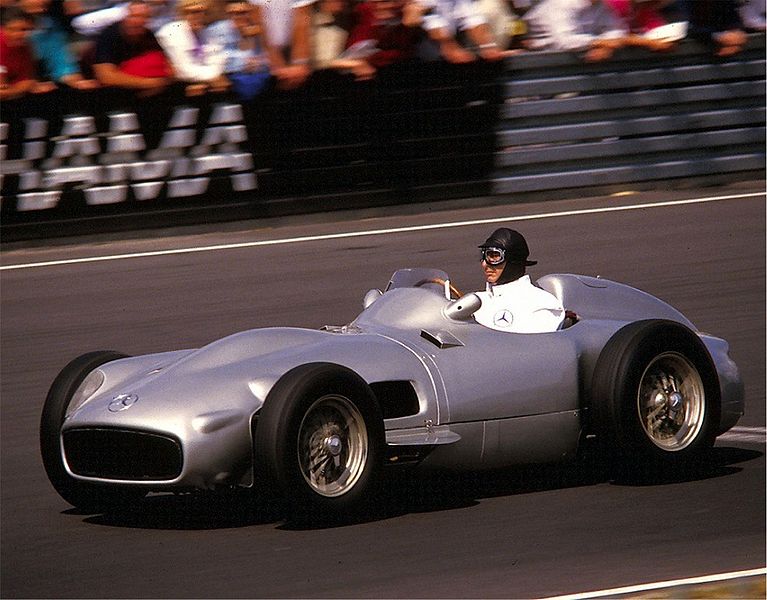
Juan Manuel Fangio (June 24, 1911 – July 17, 1995), nicknamed El Chueco ("knock - kneed") or El Maestro ("The Master"), was a racing car driver from Argentina, who dominated the first decade of Formula One racing. He won five Formula One World Drivers' Championships — a record which stood for 46 years until bested by Michael Schumacher — with four different teams (Alfa Romeo, Ferrari, Mercedes - Benz and Maserati), a feat that has not been repeated.
A member of the Formula 1 Hall of Fame, he is regarded by many as one of the greatest F1 drivers of all time and holds the highest winning percentage in Formula One, 47.06%.
Fangio is the only Argentine driver to have won the Argentine Grand Prix, having won it four times in his career.
Fangio was born on San Juan's day in 1911 in Balcarce, a city in Buenos Aires Province (Argentina). His father Loreto, immigrated to Argentina from the small, central Italian town of Castiglione Messer Marino. His mother Erminia Dérano from Tornareccio. Both parents are from the Chieti province, of the Abruzzo region.
He began his racing career in Argentina in 1934, driving a 1929 Ford Model A which he had rebuilt. During his time racing in Argentina, he drove Chevrolet cars and was Argentine National Champion in 1940 and 1941. He first came to Europe to race in 1948, funded by the Argentine Automobile Club and the Argentine government.
Fangio, unlike later Formula One drivers, started his racing career at a mature age and was the oldest driver in many of his races. During his career, drivers raced with almost no protective equipment. Fangio had no compunction about leaving a team, even after a successful year or even during a season, if he thought he would have a better chance with a better car. As was then common, several of his race results were shared with team mates after he took over their car during races when his own had technical problems. His rivals included Alberto Ascari, Giuseppe Farina and Stirling Moss.
Fangio's first entry into Formula One came in the 1948 French Grand Prix at Reims, where he started his Simca Gordini from 11th on the grid but retired. He did not drive in F1 again until the following year at Sanremo, but having upgraded to a Maserati 4CLT/48 sponsored by the Automobile Club of Argentina he dominated the event, winning both heats to take the aggregate win by almost a minute over Prince Bira. Fangio entered a further six F1 races in 1949, winning four of them against top level opposition.
For the first Formula One World Drivers' Championship in 1950 Fangio was taken on by the Alfa Romeo team alongside Farina and Luigi Fagioli. With competitive racing machinery following the Second World War still in short supply, the pre-war Alfettas proved dominant. Fangio won each of the three races he finished, but Farina's three wins and a fourth place allowed him to take the title. In 1950s non - championship races Fangio took a further four wins and two seconds from eight starts. Fangio won three more championship races for Alfa in 1951 in the Swiss, French and Spanish Grands Prix, and with the improved Ferraris taking points off his team mates, Fangio took the title in the final race, six points ahead of Ascari.
With the 1952 World Championship being run to Formula Two specifications, Alfa Romeo were unable to use their supercharged Alfettas and withdrew. As a result the defending champion found himself without a car for the first race of the championship and remained absent from F1 until June, when he drove the British BRM V16 in non - championship F1 races at Albi and Dundrod. Fangio had agreed to drive for Maserati in a non - championship race at Monza the day after the Dundrod race, but having missed a connecting flight he decided to drive through the night from Paris, arriving half an hour before the start. Badly fatigued, Fangio started the race from the back of the grid but lost control on the second lap, crashed into a grass bank, and was thrown out of the car as it flipped end over end. He was taken to hospital with multiple injuries, the most serious being a broken neck, and spent the rest of 1952 recovering in Argentina.
Back to full racing fitness, Fangio began 1953 by winning the Carrera Panamericana in a Lancia D24. Back in Europe he rejoined Maserati for the championship season, and against the dominant Ferraris led by Ascari he took a lucky win at Monza. Fangio qualified second with Bonetto seventh, and Fangio set fastest lap on his way to a 1.4-second victory over Nino Farina while Bonetto retired out of fuel. Along with that win, Fangio secured three second places to finish second in the Championship, and also came third first time out in the Targa Florio.
In 1954 Fangio raced for Maserati until Mercedes - Benz entered competition in mid season. Winning eight out of twelve races (six out of eight in the championship) in that year, he continued to race with Mercedes — driving the W196 Monoposto — in 1955 in a team that included Stirling Moss. At the end of the second successful season (which was overshadowed by the 1955 Le Mans disaster in which more than 80 spectators were killed, an accident which happened right in front of and nearly killed him) Mercedes withdrew from racing and after 4 attempts, Fangio never raced at Le Mans again.
In 1956 Fangio moved to Ferrari, replacing Ascari, who had been killed in an accident, to win his fourth title. Enzo Ferrari and Fangio did not have a very warm relationship, despite their shared success. Fangio took over his team mate's cars after his suffered mechanical problems in three races, the Argentine, Monaco and Italian Grands Prix. In each case the points were shared between the two drivers. At the season ending Italian Grand Prix, Fangio's Ferrari team mate Peter Collins, who was in a position to win the World Championship with just 15 laps to go, handed over his car to Fangio. They shared the six points won for second place, giving Fangio the World title.
In 1957 Fangio returned to Maserati, who were still using the same iconic 250F which Fangio had driven at the start of 1954. Fangio started the season with a hat trick of wins in Argentina, Monaco and France, before retiring with engine problems in Britain. At the next race, the German Grand Prix at the Nürburgring circuit, Fangio needed to extend his lead by six points to claim the title with two races to spare. From pole position Fangio dropped to third behind the Ferraris of Hawthorn and Collins but managed to get past both by the end of the third lap. Fangio had started with half - full tanks since he expected that he would need new tires halfway through the race. In the event Fangio pitted on lap 13 with a 30 second lead, but a disastrous stop left him back in third place and 50 seconds behind Collins and Hawthorn. Fangio came into his own, setting one fastest lap after another, culminating in a record breaking time on lap 20 a full eleven seconds faster than the best the Ferraris could do. On the penultimate lap Fangio got back past both Collins and Hawthorn, and held on to take the win by just over three seconds. With Musso finishing down in fourth place, Fangio claimed his fifth title. This performance is often regarded as the greatest drive in Formula One history, and it was to be Fangio's last win.
After his series of consecutive championships he retired in 1958, following the French Grand Prix. Such was the respect for Fangio, that during that final race, race leader Hawthorn had lapped Fangio and as Hawthorn was about to cross the line, he braked and allowed Fangio through so he could complete the 50-lap distance in his final race. He would cross the line over two minutes down on Hawthorn. He won 24 World Championship Grands Prix from 52 entries - a winning percentage of 47.06%, the best in the sport's history (Alberto Ascari, who is in second, holds a percentage of 40.63%).
During the rest of his life after retiring from racing Fangio sold Mercedes - Benz cars, often driving his former race cars in demonstration laps. Even before he joined the Mercedes Formula One team, in the mid 1950s, Fangio had acquired the Argentine Mercedes concession. He was appointed President of Mercedes - Benz Argentina in 1974, and its Honorary President for Life in 1987.
Cuban rebels kidnapped him on February 23, 1958 while he was racing at the 1958 Cuban Grand Prix, but he was later released, and remained a good friend of his captors afterwards. The incident was dramatized in a 1999 Argentine film directed by Alberto Lecchi, Operación Fangio.
Following his retirement, Fangio was active in assembling automotive memorabilia associated with his racing career. This led to the creation of the Museo Juan Manuel Fangio, which opened in Balcarce in 1986.
Fangio was inducted into the International Motorsports Hall of Fame in 1990. He returned to the spotlight in 1994, when he publicly opposed a new Province of Buenos Aires law denying driver's licenses to those over 80 (which included Fangio). Denied a renewal of his card, Fangio reportedly challenged Traffic Bureau personnel to a race between Buenos Aires and seaside Mar del Plata, a 400 km (250 mi) distance, in two hours or less, following which an exception was made for the five time champion.
Juan Manuel Fangio died in Buenos Aires in 1995, at the age of 84. He was buried in his home town of Balcarce in Argentina. His pall bearers were his younger brother Ruben Renato ("Toto"), Moss, compatriot racers José Froilán González and Carlos Reutemann, Jackie Stewart, and the president of Mercedes - Benz Argentina.
The official Formula One website states of Fangio: "Many consider him to be the greatest driver of all time." Several highly successful later drivers, such as Jim Clark, Alain Prost, Ayrton Senna and Michael Schumacher, have been compared with Fangio. However, it is acknowledged that such comparisons are not realistic, since the qualities required for success, the levels of competition, and the rules have changed over time.
His record of five World Championship titles stood for 45 years, until German driver Michael Schumacher took his sixth title in 2003. Schumacher said, "Fangio is on a level much higher than I see myself. What he did stands alone and what we have achieved is also unique. I have such respect for what he achieved. You can't take a personality like Fangio and compare him with what has happened today. There is not even the slightest comparison."
In his home country of Argentina, Fangio is revered as one of the greatest sportsmen the nation has ever produced. Argentines often refer to him as El Maestro, el mejor, which loosely translates into The Teacher, the best one.
The first Michel Vaillant story was partly based on an imaginary conflict stirred up by fictional newspaper The New Indian on Fangio winning the World Championship at the Indy 500.
His nephew, Juan Manuel Fangio II, was also a successful racing driver.
Six statues of Fangio, sculpted by Catalan artist Joaquim Ros Sabaté, stand at race venues around the world: Puerto Madero, Buenos Aires; Monte Carlo, Monaco; Montmeló, Spain; Nürburgring, Germany; Stuttgart - Untertürkheim, Germany; and Monza, Italy.
In 1986, an automobile museum was established in Balcarce, Fangio's birthplace, and named the Museo Juan Manuel Fangio (Juan Manuel Fangio Museum).
Argentina's former national oil and gas company, Repsol YPF, launched the "Fangio XXI" gas brand. In 2005, the Zonda 2005 C12 F was named after him because of his endorsement (the Zonda was originally intended to be named "Fangio F1," but was changed out of respect after his death). In 2007 Maserati created a special website to commemorate the 50th anniversary of his fifth and final world championship triumph.
